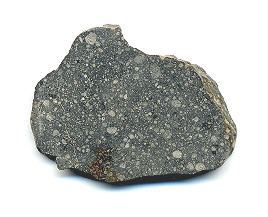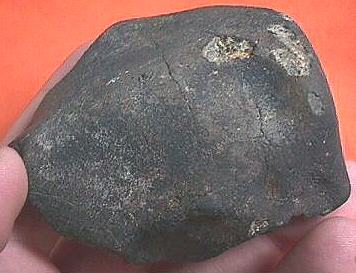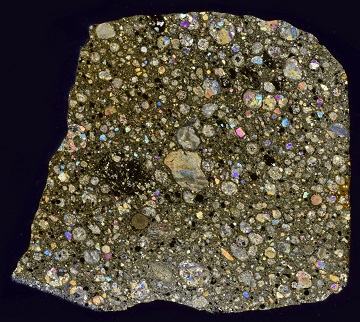R3.8, rumurutiiteMember of a rare group of chondrites, formerly named the Carlisle Lakes group, after a meteorite found in Australia in 1977. It is now named for the type specimen Rumuruti that fell in Kenya, Africa, in 1934. Rumuruti is the only witnessed fall of this group and only one small

Purchased August 1, 2001
coordinates not recorded Three fragments weighing together 722 g were purchased in Erfoud, Morocco. Classification was performed at UCLA, and Northwest Africa 978 was determined to be an R3.8 chondriteChondrites are the most common meteorites accounting for ~84% of falls. Chondrites are comprised mostly of Fe- and Mg-bearing silicate minerals (found in both chondrules and fine grained matrix), reduced Fe/Ni metal (found in various states like large blebs, small grains and/or even chondrule rims), and various refractory inclusions (such Click on Term to Read More. Although it was initially assigned a relatively low weathering grade of W2, a more useful weathering index (wi) has since been developed by Rubin and Huber (2005) for those oxidizedOxidation and reduction together are called redox (reduction and oxidation) and generally characterized by the transfer of electrons between chemical species, like molecules, atoms or ions, where one species undergoes oxidation, a loss of electrons, while another species undergoes reduction, a gain of electrons. This transfer of electrons between reactants Click on Term to Read More meteoriteWork in progress. A solid natural object reaching a planet’s surface from interplanetary space. Solid portion of a meteoroid that survives its fall to Earth, or some other body. Meteorites are classified as stony meteorites, iron meteorites, and stony-iron meteorites. These groups are further divided according to their mineralogy and Click on Term to Read More groups lacking significant FeNi-metal phases, such as the CK and R chondrite groups. This index is based on the modal abundance of brown-stained silicates as visually determined on a thin sectionThin slice or rock, usually 30 µm thick. Thin sections are used to study rocks with a petrographic microscope. in transmitted light at ~100× magnification. It is thought that the brown staining in R chondritesChondrites are the most common meteorites accounting for ~84% of falls. Chondrites are comprised mostly of Fe- and Mg-bearing silicate minerals (found in both chondrules and fine grained matrix), reduced Fe/Ni metal (found in various states like large blebs, small grains and/or even chondrule rims), and various refractory inclusions (such Click on Term to Read More (and CK chondrites) is caused by the terrestrial decomposition and mobilization of sulfides (mainly pyrrhotiteIron sulfide group of minerals whose composition ranges widely between its end members pyrrhotite (Fe7S8) whose crystal structure is monoclinic, and troilite (FeS) whose crystal structure is hexagonal. Its general formula is Fe1−xS (where x = 0 to 0.17). The troilite phase is found mainly in meteorites and in the Click on Term to Read More and pentlanditeFe-Ni sulfide, (Fe,Ni)9S8, that is often associated with troilite, and found in the matrix and chondrules of CO, CV, CK and CR chondrites. The color is yellow-bronze with light bronze-brown streak and metallic luster. It typically forms during cooling of magmatic sulfide melts during the evolution of parent silicate melt. The Click on Term to Read More), which are typically prevalent in this meteorite group; e.g., Rumuruti wi-0 contains 8.0 wt% sulfides. Northwest Africa 978 was determined to have a weathering index of wi-5, or severely weathered. This meteorite has been weakly shocked (S3).
In their
noble gasElement occurring in the right-most column of the periodic table; also called "inert" gases. In these gases, the outer electron shell is completely filled, making them very unreactive. Click on Term to Read More studies, Schultz
et al. (2005) suggested pairing several R chondrite finds of similar
petrologic typeMeasure of the degree of aqueous alteration (Types 1 and 2) and thermal metamorphism (Types 3-6) experienced by a chondritic meteorite. Type 3 chondrites are further subdivided into 3.0 through 3.9 subtypes. with NWA 978 (
21Ne-based CRE age of 10.8 (±0.4) m.y.), including NWA 755, NWA 845, NWA 851, and NWA 1471. Subsequent noble gas analyses of the known Northwest Africa R chondrites were conducted by Vogel
et al. (2011, 2014). Their ~16 groupings vary slightly from the previous pairings suggested by other investigators, and they propose an ~10 m.y. CRE age group representing possible common source craters and/or
fallMeteorite seen to fall. Such meteorites are usually collected soon after falling and are not affected by terrestrial weathering (Weathering = 0). Beginning in 2014 (date needs confirmation), the NomComm adopted the use of the terms "probable fall" and "confirmed fall" to provide better insight into the meteorite's history. If Click on Term to Read More events which includes R chondrites with the NWA series designations 755, 845, 851, 978, 1471, 2198, and 5069, and possibly DaG 013.
This is a unique group of chondrites having a higher volume of
olivineGroup of silicate minerals, (Mg,Fe)2SiO4, with the compositional endpoints of forsterite (Mg2SiO4) and fayalite (Fe2SiO4). Olivine is commonly found in all chondrites within both the matrix and chondrules, achondrites including most primitive achondrites and some evolved achondrites, in pallasites as large yellow-green crystals (brown when terrestrialized), in the silicate portion Click on Term to Read More (FeO-rich), a lower volume of
pyroxeneA class of silicate (SiO3) minerals that form a solid solution between iron and magnesium and can contain up to 50% calcium. Pyroxenes are important rock forming minerals and critical to understanding igneous processes. For more detailed information, please read the Pyroxene Group article found in the Meteoritics & Classification category. Click on Term to Read More, and essentially no FeNi-metal as compared to all other chondrite groups. This is thought to be the result of metasomatic
oxidationOxidation and reduction together are called redox (reduction and oxidation) and generally characterized by the transfer of electrons between chemical species, like molecules, atoms or ions, where one species undergoes oxidation, a loss of electrons, while another species undergoes reduction, a gain of electrons. This transfer of electrons between reactants Click on Term to Read More in which FeNi-metal and pyroxene reacted with water to form olivine (Isa
et al., 2010). While R chondrites share certain similarities with ordinary chondrites including refractory
elementSubstance composed of atoms, each of which has the same atomic number (Z) and chemical properties. The chemical properties of an element are determined by the arrangement of the electrons in the various shells (specified by their quantum number) that surround the nucleus. In a neutral atom, the number of Click on Term to Read More depletions and
siderophile elementLiterally, "iron-loving" element that tends to be concentrated in Fe-Ni metal rather than in silicate; these are Fe, Co, Ni, Mo, Re, Au, and PGE. These elements are relatively common in undifferentiated meteorites, and, in differentiated asteroids and planets, are found in the metal-rich cores and, consequently, extremely rare on abundances, they differ in
volatileSubstances which have a tendency to enter the gas phase relatively easily (by evaporation, addition of heat, etc.). element abundances and petrologic trends. The triple increase in Zn relative to ordinary chondrites and the sparsity of
metalElement that readily forms cations and has metallic bonds; sometimes said to be similar to a cation in a cloud of electrons. The metals are one of the three groups of elements as distinguished by their ionization and bonding properties, along with the metalloids and nonmetals. A diagonal line drawn Click on Term to Read More, or lack thereof, observed in some R chondrites, indicates that this group experienced highly
oxidizingOxidation and reduction together are called redox (reduction and oxidation) and generally characterized by the transfer of electrons between chemical species, like molecules, atoms or ions, where one species undergoes oxidation, a loss of electrons, while another species undergoes reduction, a gain of electrons. This transfer of electrons between reactants Click on Term to Read More conditions both in the
nebulaAn immense interstellar, diffuse cloud of gas and dust from which a central star and surrounding planets and planetesimals condense and accrete. The properties of nebulae vary enormously and depend on their composition as well as the environment in which they are situated. Emission nebula are powered by young, massive Click on Term to Read More and on the parent asteroid.
Parent bodyThe body from which a meteorite or meteoroid was derived prior to its ejection. Some parent bodies were destroyed early in the formation of our Solar System, while others like the asteroid 4-Vesta and Mars are still observable today. Click on Term to Read More metamorphism in an oxidizing, water-rich environment is attested by the hydroxyl-rich minerals amphibole, phlogopite, and apatite present in the R6 chondrites LAP 04840 and MIL 11207. It is considered that these chondrites experienced metamorphism of insoluble
organicPertaining to C-containing compounds. Organic compounds can be formed by both biological and non-biological (abiotic) processes. Click on Term to Read More matter at high temperatures (~720°C) and at significant depth (tens of km) within a lithologic unit in which water with a high D/H ratio was pervasive. This deep burial is considered to be the result of reassembly following impact disruption on the R chondrite parent body (McCanta
et al., 2006, 2008). In a study of these two hydroxyl-bearing R chondrites, Gross
et al. (2017) reasoned that such high abundances of hydrous phases could only be established under conditions of high water vapor pressure (20–700
barUnit of pressure equal to 100 kPa.), and such pressures could only be maintained on this relatively small body through the emplacement of a solid ice shield.
The difference in O-isotopic abundances between the R chondrites and the ordinary chondrites is greater than it is among the H, L, and LL
ordinary chondriteWork in Progress Ordinary chondrites (OCs) are the largest meteorite clan, comprising approximately 87% of the global collection and 78% of all falls (Meteoritical Society database 2018)1. Meteorites & the Early Solar System: page 581 section 6.1 OC of type 5 or 6 with an apparent shock stage of S1, Click on Term to Read More groups, further resolving the R group from the ordinary chondrite groups (Weber
et al., 1997). Similar to carbonaceous chondrites, R chondrites have a high olivine content within a high proportion of
matrixFine grained primary and silicate-rich material in chondrites that surrounds chondrules, refractory inclusions (like CAIs), breccia clasts and other constituents. Click on Term to Read More, reflecting their highly oxidized nature. Because R chondrites have the highest
17O value of any other
Solar SystemThe Sun and set of objects orbiting around it including planets and their moons and rings, asteroids, comets, and meteoroids. material, they plot on a different O-isotope trend line than the other chondrites. This plot is farther from the carbonaceous and
enstatiteA mineral that is composed of Mg-rich pyroxene, MgSiO3. It is the magnesium endmember of the pyroxene silicate mineral series - enstatite (MgSiO3) to ferrosilite (FeSiO3). Click on Term to Read More chondrites than it is from the ordinary chondrites (Rubin and Kallemeyn, 1989). Rumuruti chondrites of type 3 contain noble metals such as platinum, osmium, and germanium that originated as nebular condensates. In higher
metamorphicRocks that have recrystallized in a solid state due to changes in temperature, pressure, and chemical environment. Click on Term to Read More types, the volatile germanium phases are decomposed, while other noble metal phases are transformed into mostly arsenides and tellurides.
In addition to NWA 978 (R3.8), several other unbrecciated R chondrites have been recovered so far, including the following: Sah 99527 and NWA 1668 (both R5); HaH 119, Ouzina, NWA 053, NWA 800, and Sah 98248 (all R4); NWA 753 (R3.9); Carlisle Lakes (R3.8); NWA 755 (R3.7); and Acfer 217 (R3.8–5). The photo above shows a 3.5 g slice of NWA 978, while the top photo below shows the fresh
fusion crustMelted exterior of a meteorite that forms when it passes through Earth’s atmosphere. Friction with the air will raise a meteorite’s surface temperature upwards of 4800 K (8180 °F) and will melt (ablate) the surface minerals and flow backwards over the surface as shown in the Lafayette meteorite photograph below. Click on Term to Read More on the 361.6 g
main massLargest fragment of a meteorite, typically at the time of recovery. Meteorites are commonly cut, sliced or sometimes broken thus reducing the size of the main mass and the resulting largest specimen is called the "largest known mass". Click on Term to Read More. The bottom image is an excellent petrographic thin section micrograph of NWA 978, shown courtesy of Peter Marmet.

Photo courtesy of Mike Farmer—
Mike’s Meteorites and Tektites
 click on image for a magnified view
click on image for a magnified view Photo courtesy of Peter Marmet









